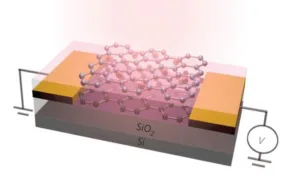Researchers in the Department of Electrical Engineering and Computer Science at the University of Michigan (Ann Arbor, MI) are developing a new 3D camera based on the use of graphene as the light detector.

First, a few words of background information.
In a conventional camera, light impacts the detector from a range of directions. Since the detector only measures intensity, the directional information is lost and cannot be used to reconstruct 3D images. This is the reason 3D images made with traditional cameras are composed from two or more images.
A different approach is used in some one-shot 3D cameras. These are based on an array of microlens that serve to divert the light after it has been focused by the main camera lens. The array of smaller lenses “breaks down” the image in a way that enables determination of both light intensity and ray direction. The camera’s software uses this information to reconstruct the image along with a determination of the depth of objects within the image. Unfortunately, the microlens approach requires a tradeoff between image resolution and the ability to resolve depth.
The new approach eliminates the microlens array. Instead, the camera records light as it passes through a stack of transparent light detector arrays. The idea behind this approach is that light from objects at different distances from the camera lens will be focused at different levels within the detector stack. The focal depth can be identified because objects will appear brightest at the depth within the stack at which they are most in focus. Given this information, the computer can reconstruct the images using a “fast’ computational process. By this means it is possible to produce both high speed and high resolution video.
The challenge in implementing this approach is dealing with the need for the light detector to absorb enough light to produce a valid measurement and, thus, produce a quality image.
One candidate light detecting material is graphene. It has the advantage of being able to absorb light across that whole spectrum. Unfortunately, up to now, graphene has not been viable for use in practical applications because it cannot capture enough light to generate a detectable electrical signal. The reason for this is that graphene consists of a single layer of carbon atoms and absorbs only about 2.3% of incident light. This is far less than is required in a commercially viable device.
To address this problem, the team designed a new way of generating the electrical signal. The detector is a phototransistor composed of a double layer heterostructure. In it, there are a pair of stacked graphene monolayers in which the top layer is the gate and the bottom layer is the channel. These are separated by a thin insulating barrier layer.
Rather than trying to directly measure the electrons that are freed when light impacts the graphene, the signal is amplified by detecting how the light induced electrical charges in the graphene and affects a nearby current.
More specifically, a current is run through the bottom layer. When light impacts the top layer, it frees electrons, creating positively charged holes. These electrons quantum tunnel through the barrier and into the bottom layer of graphene. The positively charged holes, left behind in the top layer, produced an electric field that affected the flow of electricity through the bottom layer. By measuring the change in current, it is possible to determine the brightness of the light impacting the graphene.
The new approach allows the sensitivity of a room temperature graphene device to be higher than 1 A/W. This value meets the requirements of most applications.
The detector device is already physically small and is reported as easy to scale down. The researchers suggest that arrays of such super thin detectors can be used as sensors in cameras. In fact, the team is considering development of a SLR sized camera as a first step but believe that it may be possible to squeeze 3D camera capability into a smartphone.
Looking towards the future, the researchers stated that “Our work pioneered a new way to detect light. We envision that people will be able to adopt this same mechanism in other material and device platforms. -Arthur Berman
University of Michigan, Zhaohui Zhong. 734-647-1953, [email protected]

